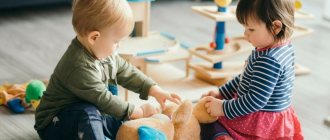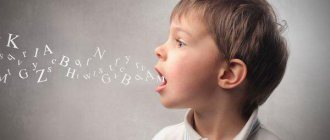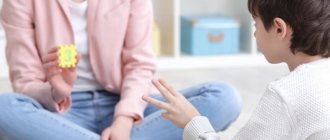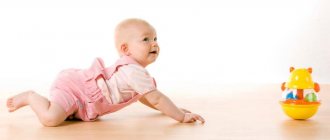Structure and types of leading activities
There are three signs by which a leading activity can be determined:
- leading activity contributes to the emergence of new actions for the child, which he masters over time;
- thanks to it, the formation and restructuring of individual functions of the psyche of a growing person occurs;
- Visible personality changes depend on it.
The mental development of a child is determined by the appropriate type of leading activity. A change in its types means a transition from one stage of development to another, more advanced one.
The stages of human mental development from infancy to senior preschool age are characterized by a certain triune structure of leading activity:
- persisting – moved from the previous stage;
- immediate – characteristic of the current stage;
- nascent - one that is just beginning to develop and will be the leader at the next stage.
Developmental psychology identifies the following types of leading activities at different stages:
- direct emotional communication between the child and the adults around him (from 0 to 1 year);
- object-manipulative (from one to 3 years);
- play (from 3 to 7 years).
For younger schoolchildren (6-11 years old), educational activities are a priority, and for adolescents 11-15 years old, communication is the priority.
Let us take a closer look at the most significant age period for further human development, from 0 to 7 years.
Fourth month of life
At the fourth month, the baby can already hold his head independently, can gesture well with his legs and arms, examines objects around him, and rolls over from his back to his tummy. At this time, he not only looks at objects, but also sees them. Perceives voices and sounds around. Feels the need for her mother not only to study herself, but also everything around her.
The parent must monitor the baby’s daily routine and adjust it if necessary. At 3-4 months, the average baby needs 15 hours of sleep. 10 hours are at night, and the rest are distributed evenly throughout the day.
If adults have decided that the child should sleep only in his own bed, then he should only be placed there, thereby instilling discipline and habit.
Leading activity from 0 to 1 year
The beginning of a newborn's life is characterized by the fact that he is completely dependent on the mother or the person replacing her. In the full sense of its significance, the leading type of activity from 0 to 2 months has not yet been determined. Starting from the second period (from 2 to 12 months), for the baby this becomes direct emotional communication with the closest person - the mother. It allows the formation of new formations in the psyche that were not previously inherent in the baby:
- separation of sensations and emotional states;
- involuntary attention (the child is capable of short-term fixation on certain objects);
- the beginnings of visual and effective thinking;
- perception of objects;
- autonomous speech.
The leading activities of infancy form the central, most important new formation that determines the transition to the next stage of development - an ever-increasing need for communication with surrounding adults.
Second month of life
Communication is the leading activity of infancy. Physical contact with parents is additionally added to communication. The child needs to be given a feeling of security and closeness, carried in his arms, massaged, smiling and trying to evoke a response.
In the second month of life, parental education continues to focus on the development of vision and hearing. Objects for study are already placed at a distance of 30 to 50 centimeters. The sounds to learn become multifaceted.
In order to develop tactile sensitivity, the baby needs to be given toys and objects of different shapes. So that the child can hold his head independently in the future without any problems, they begin to roll a bright ball in front of him. The baby will watch him closely, thereby tensing his neck muscles.
Leading early childhood activities
In infancy, leading activities formed the psychological properties of the child, which allowed him to move to a higher level of development. Now, object-manipulative actions become decisive, through which children learn about the world around them, filled with many different objects. This whole process takes place under the close attention of adults.
The peculiarity of early age lies in a certain separation of the lines of development of the psyche of boys and girls. For boys, object-tool activities become quite important, and for girls, communicative activities. This occurs due to the specifics of communication with them: cultural patterns of relationships in society orient boys and girls to different types of activities. Therefore, the former have more developed abstract thinking, while the latter have more developed social thinking.
Leading activity at an early age forms the following psychological new formations in children of both sexes:
- self-esteem;
- visual-effective thinking;
- recognition with reproduction;
- development of active speech;
- formation of involuntary attention;
- formation of the self-concept (I am myself).
The child requires more trust and a significant amount of independence.
Third month of baby's life
The leading type of activity in infancy of three months will be the ability to show emotions. In order for the baby to develop facial muscles, begin to laugh, walk, and show different emotions, it is important to pay increased attention to him. The parent should often hold the baby in his arms, talk to him for a long time, tell stories, read books, laugh.
Toys at this age will be bells, bells, balloons, rattles and everything that the baby can reach and feel tactilely. The parent is obliged to help the child explore the world around him and not forbid him to be curious.
At this stage of development, the baby begins to copy many of the parents’ gestures and habits, and also takes into account their attitude. For example, if the baby’s mother feels fear, the child will feel the same.
To develop only positive qualities in a child, you should show him as many positive emotions as possible, smile often and give him a good mood.
Game is the leading activity in preschool age
At the stage of preschool childhood, development occurs in a situation of learning about human relationships under the influence of an ever-increasing need to imitate them. Therefore, play activity becomes the leading activity for children aged 3-7 years. By the end of the age period, it forms very important new formations in the psyche of a preschooler:
- correct speech;
- involuntary memory;
- analyzing perception;
- visual-figurative thinking;
- creative imagination;
- rudiments of voluntary memory;
- verbal thinking;
- emotional regulation of behavior.
All of them are extremely important for the further development of a full-fledged human personality. Such a large number of neoplasms appear in the process of successive changes in types of gaming activities over 4 years.
Play for a child is a way to express life experiences. In this way, he tries to enter the alluring world of adults, building his model of social relations based on imitation of the existing one. In the process of developing a child’s personality, play goes through several stages of evolution with him.
Subject game
During early childhood, object-based play is important. It is not the leading activity, but is very important for the development of the child. The baby is actively trying to try out familiar objects in new conditions. He is equally enthusiastic about spoon-feeding everyone: his mother, his car, his horse, his doll. And the spoon can be an ordinary popsicle stick. After five minutes, it will become a comb, or a thermometer for the patient. Any jar can turn into a boat or a tea cup. As a result, everyone pretends to drink tea from this cup, where they stir the same imaginary sugar in imaginary water with an imaginary stick-spoon. This is how, through objective play, the little one learns the logic of actions.
The game is plot-display
By the age of three, the child has accumulated enough experience and impressions in understanding the surrounding material world, as well as the world of human relationships. The leading activity in preschool age at this stage is plot-display play. The child plays independently with the toys he has. They are transformed into the main characters of the play invented by the little director.
Habitual dolls become mothers or children, doctors or patients. The child is still unable to distinguish the relationship between them: it is not the toy mother who feeds her son, but the baby puppeteer himself who does this for both of them. But the toddler already clearly indicates the peculiarities of human behavior in reality: his toys are capricious, angry, asking for forgiveness. That is, the game now has a plot and reflects the relationships between people.
How often do moms and dads have the opportunity to recognize themselves by looking at the behavior of a doll controlled by their daughter or son!
Role-playing game
For the older preschooler, the time has come for the most difficult type of leading activity in childhood - role-playing play. Its peculiarity and at the same time complexity: several children already become participants. They not only represent relationships in the game's plot, but also learn them in reality. It happens that a conflict arises from a game, so the children have to learn to distribute and change roles, help each other, share, and prove that they are right. At this stage, leading activities in preschool age shape a person’s business qualities, because one must be able to come to an agreement with others, give in or insist on one’s own.
The borderline age of preschool childhood is approaching ever closer, role-playing games are becoming more and more abstracted from the environment: children, using their imagination, go into space, save people on a desert island, put out fires, etc. They have to establish stricter rules, requiring detailed and precise implementation.
Constantly becoming more complex types of play require the presence and attention of adults who will have to supervise it. No, mentoring instructions should not be given out under any circumstances.
The main role of the father, mother, and educator is to provide food for the imagination of children.
Parenting in the first month of life
You should start training your baby from a very early age. It is important to remember that before one year, all the foundations for its further development are laid. Already at this stage, the child understands and perceives a lot: he reacts to sounds around him, determines the tone of conversation, melodies, distinguishes light from darkness, recognizes by smell that his mother is somewhere nearby, and feels all touches.
The child has well-developed innate reflexes, for example, he looks for his mother’s breast, sucks it, flinches from too loud or sudden sounds, walks with his legs, if you lift him and hold him in an upright position, grabs with his hands.
During this period of time, education should consist of simple methods. Develop color vision by placing bright rattle toys at a distance of about 30 centimeters from the child’s eyes. Teach gaze fixation by moving a bright toy in front of the child’s eyes at a distance of 20 centimeters, and then, after waiting for the gaze to fixate on it, move it to the other side and in the vertical direction. Form the baby's hearing by talking to him in a quiet and calm voice, turning on music and rattling rattles.
Experts also recommend carrying your child around the house, telling him about the objects around him and sharing interesting stories.
Features of education in the fifth month
The child not only hums, but also makes clearly distinguishable sounds. Seeing a toy nearby, he can touch it and also hold it firmly in his hands. He continues to perceive all things by taste and tactile sensations.
The child’s muscles and limbs have already become stronger, which gives him the opportunity to rise on his hands, stretch his legs and even get on all fours. It is important for the parent to continue to maintain as much physical contact with the infant as possible.
It is important to carry the child in your arms, talk to him often, respond to his sounds, and smile back. It will also be good to develop a sense of rhythm in the baby; for this, massage and gymnastics with counting and dancing to music should be done.
The child is very happy when he sees that he is happy. He shows emotions in different ways: he is capricious and cries to show discomfort, or he laughs and plays when he is having fun. It is important to remember that when crying loudly, the child is not manipulating his parents, but is simply showing his needs or dissatisfaction, since he does not yet know how to do this in any other way.








